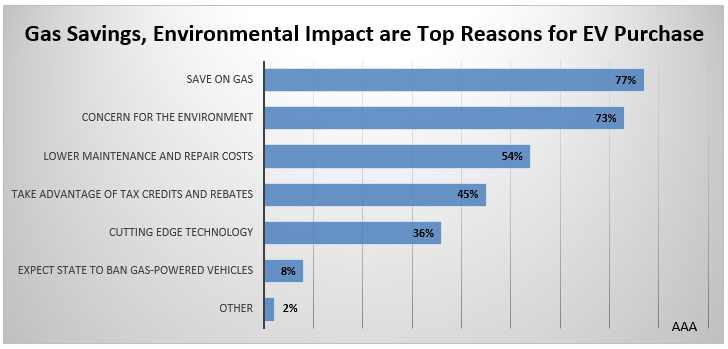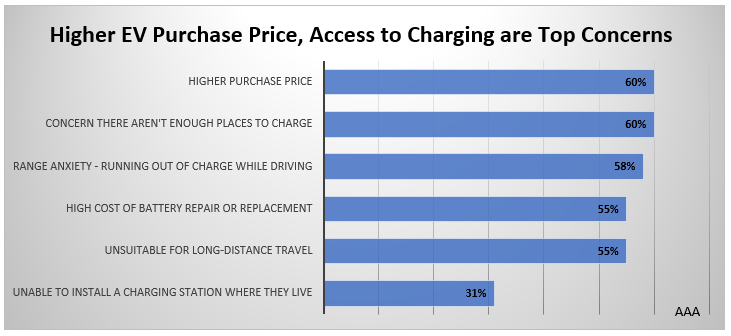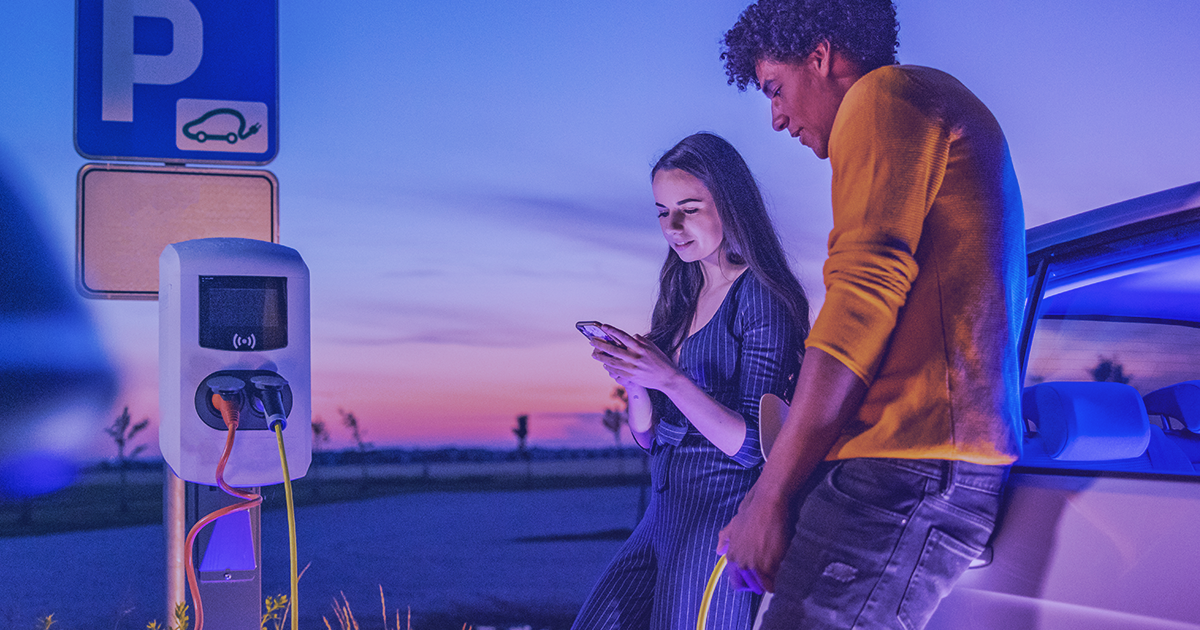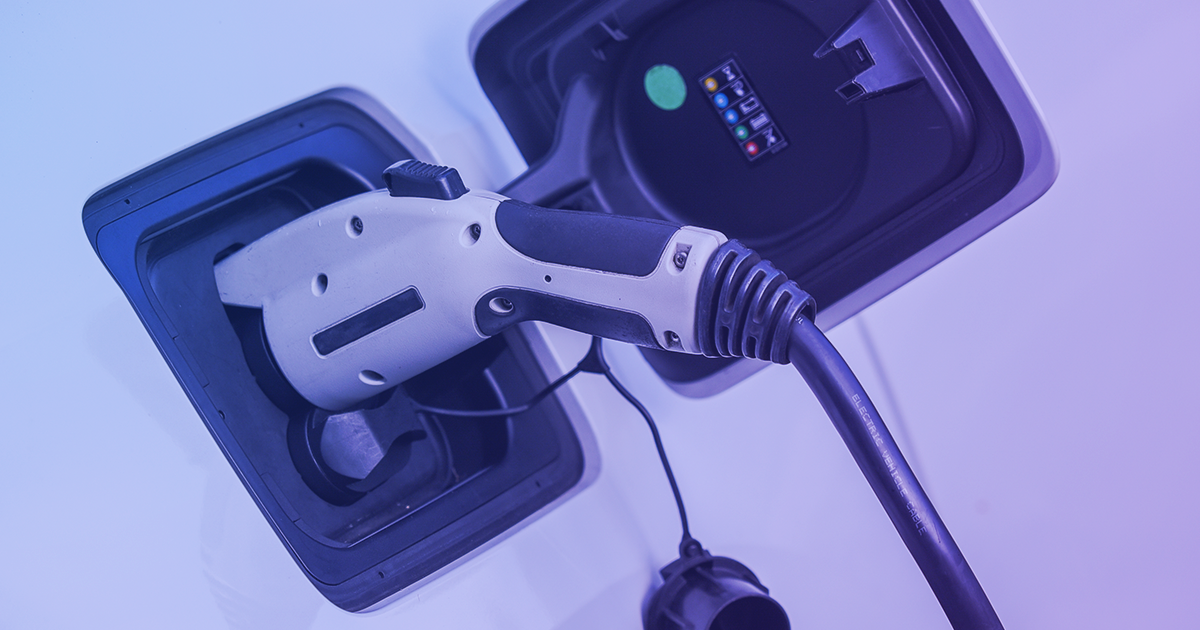PORTLAND, Ore., – New research from AAA finds that one-quarter of Americans say they would be likely to buy an electric vehicle (powered exclusively by electricity, not a hybrid or plug-in hybrid) for their next auto purchase, with Millennials and Gen Z leading the way. The number one reason is to save money on fuel – 77% say that’s why they’d want an EV. However, the AAA research also finds that consumers are still concerned about the higher purchase price of EVs, access to charging and range anxiety.
The AAA survey finds that about 24% aren’t sure about buying an EV, while 51% say they’re unlikely or very unlikely to purchase an EV. These numbers are similar to the survey done by AAA in 2019.
“Gas and diesel prices soared to record highs this spring, and that has made electric vehicles more attractive to about a quarter of all consumers, especially younger generations,” says Marie Dodds, public affairs director for AAA Oregon/Idaho. “But other factors, including the higher purchase cost of an EV, concerns about access to charging, and range anxiety, are still holding consumers back from going electric.”
Lower fuel costs and being more environmentally friendly are the top reasons why consumers say they’d purchase an EV, according to the AAA survey:

The higher purchase price of EVs compared to gas- and diesel-powered engines, access to charging and range anxiety are the top three reasons why consumers choose not to buy an EV:

Younger people are more interested in EVs
Millennials are more likely to say they would buy a fully electric vehicle for their next vehicle (30%) than Baby Boomers (16%).
Breakdown by generation:
Gen Z (Centennials) – 51%
Millennials – 30%
Gen X – 22%
Boomers – 16%
Pre-Boomers – 12%

EV Costs and Rebates
Electric vehicles cost around $56,000 on average, which is about $10,000 more than the industry average of $46,329 according to Kelley Blue Book.
Some EV buyers may qualify for a federal and/or state rebate. Battery electric vehicles (BEVs) and plug-in hybrid electric vehicles (PHEV) purchased in or after 2010 are eligible for a federal income tax credit of up to $7,500, with EVs with larger battery capacity eligible for more significant tax credits. However, this credit will phase out to 50% of the total credit amount once a manufacturer has reached 200,000 PHEVs and BEVs sold. Only two manufacturers, Tesla and General Motors have completely phased out their credits.
Oregon is one of 47 states and DC that provide an incentive to buy certain BEVs and/or PHEVs. Oregon’s Clean Vehicle Rebate Program provides rebates up to $2,500 for purchasing or leasing EVs. Rebates vary depending on battery capacity. Oregon residents who meet low- or moderate-income requirements are eligible for increased rebates up to $5,000.
EV Range
The range of electric vehicles has increased dramatically in the last several years, but consumers still worry about range anxiety.
AAA finds that consumers have a reasonably accurate understanding of current electric vehicle range. Six in ten (60%) Americans think electric vehicles can travel between 100 to 350 miles before running out of charge, which aligns with today’s electric vehicle capabilities. These findings suggest the improvement in range alone hasn’t been enough to address consumer range anxiety concerns as previously hoped.
AAA believes having a better understanding of EVs will help consumers overcome their worries:
- Performance: Electric vehicles are more efficient in stop-and-go traffic because the car can recapture energy from braking to charge the battery when decelerating.
- Public vs. Home Charging: A previous AAA survey revealed electric vehicle owners do 75% of their charging at home. Most electric vehicles come with a 120-volt, Level 1 AC charger that plugs into a standard household electrical outlet. Level 1 charging provides between 2 and 5 miles of range per hour, which is adequate for a typical U.S. driver who averages about 30 miles daily.
- Accessibility: Often, public charging is less accessible for people living in dense cities or multi-family housing. In those cases, public charging is the only option. The U.S. Department of Energy data suggests there are nearly 55,674 charging stations throughout the nation. While charging infrastructure has improved, more work will be needed to support greater consumer adoption in the coming years.
- Integration: According to previous AAA research, most owners of electric vehicles (78%) usually have one or more gas-powered or non-plug-in hybrid vehicles in the household in addition to their electric vehicles. Educating consumers on the benefits of using an electric vehicle for shorter commutes while using their gas-powered vehicle for longer trips may go a long way in addressing range anxiety while also highlighting the benefits.
- Roadside Assistance: AAA is synonymous with the automobile, whether electric or gas-powered, which includes servicing those members who own electric vehicles. AAA finds that much like gas-powered, the top reasons for roadside assistance for electric vehicle owners include issues with tires or needing a tow, but rarely for running out of charge.
Check out the AAA Car Guide for more info on EVs
This resource provides consumers with reviews highlighting how many advanced driver assistance systems (ADAS) are included in the vehicle, along with other criteria and information. All category winners for 2022 are electric, plug-in electric hybrid, or hybrid vehicles.
Find AAA reviews of electric vehicles here:
https://info.oregon.aaa.com/category/ev-car-review/
Oregon hopes to have 250,000 registered ZEVs (Zero Emission Vehicles) by 2025. As of January 2022, Oregon had 47,390 registered EVs. Currently, there are more than 2,100 chargers in 917 locations.
Oregon ranks fourth in the nation (behind California, Hawaii and Washington) when it comes to plug-in vehicles per capita. Find out more at https://goelectric.oregon.gov/ and https://www.oregon.gov/energy/Data-and-Reports/Pages/Oregon-Electric-Vehicle-Dashboard.aspx
“Electric vehicles can be a great choice for many drivers. The range of EVs has increased over the last several years, and a growing number of EVs have ranges of 300 miles or more per charge. Fuel costs are usually significantly less than traditional vehicles, and EVs cost less to maintain since they don’t need things like oil changes and air-filter replacements. There are more designs and options on the market than ever before so consumers can get an EV that meets their needs,” adds Dodds. “Anyone interested in an EV should learn as much as possible about them. Do research online, talk with friends who own EVs, visit a few dealers and take some EVs on test drives. It’s also important to understand the charging options that are available at your home and/or work,” adds Dodds.
AAA Oregon/Idaho has installed EV chargers at nine of its Service Centers in Oregon and Idaho. ChargePoint Level 2 charging spots provide complimentary charging for the first 2 hours for AAA members’ electric vehicles. The charging spots are accessible to all EV drivers through the ChargePoint app. Find the ChargePoint EV charging spots at the following AAA Service centers: Portland, Beaverton, Lake Oswego, Clackamas, Salem, Eugene, Medford, Bend, and Boise. Find the locations of each Service Center and more details about our EV charging services at AAA.com/charge.

AAA also offers mobile EV charging in the Portland area. AAA’s roadside EV charging will provide up to a 30-minute Level 2 charge using the Blink IQ-200-M mobile charging unit with the standard J1772 plug for 10 or more miles of charge to your EV so that you can get home or to a charging station. Tesla vehicles can also be charged with a Tesla J1772 adapter. The mobile electric vehicle charging truck is very similar to AAA’s other light services vehicles. The truck is equipped to allow AAA’s technicians to provide traditional AAA Roadside Assistance capabilities to all motorists, such as battery testing and replacements, jump starts, tire changes and fuel delivery.

Survey Methodology
The survey was conducted on February 18-20, 2022, using a probability-based panel designed to represent the U.S. household population overall. The panel provides sample coverage of approximately 97% of the U.S. household population. Most surveys were completed online; consumers without Internet access were surveyed over the phone. A total of 1,051 interviews were completed among U.S. adults, 18 years of age or older. The margin of error for the study overall is +/- 4% at the 95% confidence level. Smaller subgroups have larger error margins.

About AAA
AAA provides more than 62 million members with automotive, travel, insurance, and financial services through its federation of 32 motor clubs and nearly 1,000 branch offices across North America. Since 1902, the not-for-profit, fully tax-paying AAA has been a leader and advocate for safe mobility. Drivers can request roadside assistance, identify nearby gas prices, locate discounts, book a hotel or map a route via the AAA Mobile app. To join, visit AAA.com.
AAA news releases, high resolution images, broadcast-quality video, fact sheets and podcasts are available on the AAA NewsRoom at NewsRoom.AAA.com.
Find local news releases at https://oregon.aaa.com/community/media/media-contacts.html

